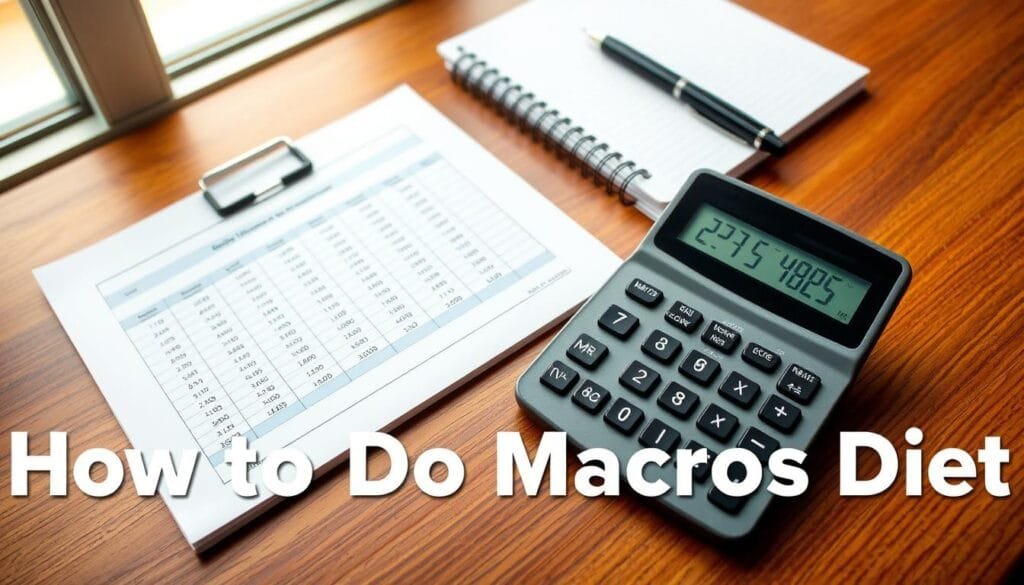Ready to supercharge your nutrition? Let’s explore how to do macros diet for amazing results. We’ll guide you through counting macros and understanding their power in your daily meals.
Macros are the core of our diet. They include proteins, carbohydrates, and fats. By focusing on these, you can boost your nutrition for various goals.
This guide covers macronutrient basics and how to do macros diet plan. You’ll learn to calculate daily calories and determine ideal macro ratios. We’ll also show you how to set up an effective tracking system.
This guide will give you the tools for macro diet success. Let’s explore how macros can transform your eating habits.
Key Takeaways
- Macronutrients consist of proteins, carbohydrates, and fats
- Counting macros can help with weight management and muscle building
- Typical macro ratios range from 45-65% carbs, 20-35% fats, and 10-35% proteins
- Accurate tracking is crucial for achieving nutritional goals
- Apps and digital food scales can assist in macro tracking
- Balancing whole foods and flexibility is key to sustainable macro dieting
- Adjusting macros based on individual goals and results is important
Understanding Macronutrients Basics
Macronutrients are the building blocks of our diet. They include protein, carbohydrates, and fats. These nutrients give us energy and help our bodies work well.
What Are Macronutrients
Macronutrients are the three main nutrients our bodies need in large amounts. They help us grow, give us energy, and keep us healthy. Each one has a special job in our body.
Importance of Proteins, Carbs, and Fats
Protein builds and fixes our body parts. Carbohydrates give us most of our energy. Fats help make hormones and absorb nutrients.
Eating the right mix of these macronutrients keeps us healthy.
Caloric Value of Each Macronutrient
Knowing how many calories macronutrients have helps us plan our meals better. Here’s how much energy they give us:
| Macronutrient | Calories per gram | Recommended daily intake |
|---|---|---|
| Protein | 4 | 10-35% of total calories |
| Carbohydrates | 4 | 45-65% of total calories |
| Fats | 9 | 20-35% of total calories |
This info helps you plan a balanced diet. It’s not just about how much you eat. The quality of your food matters too.
Choose whole foods over processed ones for better health.
How to Do Macros Diet: Essential Steps
A macros diet can boost your nutrition goals. We’ll show you how to calculate macros and set up tracking. This guide will help you create a personalized macros diet plan.
Calculating Your Daily Calorie Needs
First, figure out your daily calorie needs. Most people need about 2200 calories per day. For weight loss, aim for 1700 calories daily.
This 500-calorie deficit can lead to changes within a week. You’ll see bigger results in 3-4 weeks.

Determining Your Macro Ratios
Next, break down your calories into macro ratios. A common split is 50% carbs, 25% fat, and 25% protein. These can change based on your activity and goals.
If you exercise an hour or less daily, try 40% carbs, 30% fat, and 30% protein.
Setting Up Your Tracking System
Tracking macros is key to success. Use a food journal or app to log what you eat. Here’s a quick guide for macro calculations:
- Carbohydrates: 4 calories per gram
- Protein: 4 calories per gram
- Fat: 9 calories per gram
For 1700 calories with 50% carbs, aim for 213 grams of carbs daily. Use this method for protein and fat too.
Stay consistent with tracking to see results. Keep at it, and you’ll reach your nutrition goals!
Tools and Resources for Macro Tracking
Modern tech makes macro tracking easier. Here are top tools to help you reach your diet goals.
Best Macro Tracking Apps
Macro tracking apps are vital for diet management. MyFitnessPal has over 11 million foods in its database. It syncs with Fitbit, Garmin, and Apple Watch.
Macros First lets you set targets for individual meals. Cronometer tracks over 60 nutrients and allows custom macro goals without a paywall.
| App | Key Features | Database Size |
|---|---|---|
| MyFitnessPal | Device integration, Premium features | 11 million+ foods |
| Macros First | Meal-specific targets, Quality data | Smaller, more accurate |
| Cronometer | 60+ nutrients tracked, Free custom goals | Smaller, requires manual entry |
Digital Food Scales and Measuring Tools
Accurate measurements are crucial for macro tracking. A reliable food scale helps measure portions precisely. It improves your tracking consistency and results.
Fitness trackers like Apple Watch and Fitbit can estimate calorie burn. This enhances your macro calculations.

Food Journals and Planning Templates
Food journals and meal planning templates help organize meals offline. Websites like Working Against Gravity and Skinnytaste offer macro-friendly recipes.
Even 65% accuracy in macro tracking is beneficial for your diet goals.
Over 30,000 individuals have reached their goals through consistent macro tracking.
Choose the tools that fit your lifestyle. You’re now ready to start your macro tracking journey!
Check This:
- 10 Essential Tips on How to Follow a Macro Diet for Success
- 10 Effective Tips on How to Follow a Diet Without Cheating
Macro-Friendly Food Choices
Macro-friendly foods are crucial for success in a macros diet. We’ve listed nutrient-dense options to help you create balanced meals. These choices will help you meet your macro goals.
Lean meats like chicken breast offer 25 grams of protein per 4-ounce serving. Fish, such as salmon, provides protein and healthy fats. Plant-based options include tofu and black beans.
Fruits and vegetables are excellent carbohydrate choices. A banana contains about 27 grams of carbs. Whole grain and chickpea pasta offer more protein and fiber.
Avocados, nuts, and olive oil are great for healthy fats. A medium avocado has 21 grams of healthy fats. An ounce of almonds delivers about 14 grams.
| Meal Idea | Protein | Carbs | Fat |
|---|---|---|---|
| Overnight Oats | 32g | 45g | 9g |
| Mediterranean Chicken Bowl | 38g | 45g | 14g |
| Protein Smoothie | 24g | 30g | 4g |
Meal prepping saves money and time. Organize your grocery list by department for efficient shopping. Choose these macro-friendly foods to create nutritious, balanced meals.
Common Mistakes to Avoid When Counting Macros
Macro counting can transform your diet, but it’s easy to make mistakes. We’ve found 11 common errors that can mess up your plans. Let’s look at these issues and learn how to avoid them.
Overlooking Hidden Macros
Hidden macros are in surprising places. Drinks often have sugars and fats you might miss. Don’t forget to track what you drink!
Packaged foods seem handy for macro info but aren’t always healthy. Choose whole foods when you can for better health.
Inconsistent Tracking
Consistency matters in macro tracking. Many people guess portion sizes or use generic food entries. A “medium banana” can have very different calorie counts.
Get a food scale for accuracy. Remember, small bites and tastes add up fast!
Not Adjusting Macros Based on Results
Your macro needs can change. It’s important to review and adjust based on your progress. Wait two weeks after changing your macros before checking results.
This gives your body time to show real changes.
| Mistake | Impact | Solution |
|---|---|---|
| Overlooking hidden macros | Underestimating calorie intake | Track all food and drinks, focus on whole foods |
| Inconsistent tracking | Inaccurate macro counts | Use a food scale, log everything |
| Not adjusting macros | Stalled progress | Reassess every 2-4 weeks, make necessary changes |
Avoid these mistakes to get better results with macro counting. Remember, progress matters more than being perfect. Stay consistent and be aware of hidden macros.
Don’t be afraid to change your approach when needed. Keep track and adjust for the best results.
Benefits and Potential Challenges
A macro diet offers rewards and hurdles. Let’s explore how this approach might affect your life.
Weight Management Advantages
Macro diets help manage weight effectively. By tracking protein, carb, and fat intake, you control calories better.
This precision can lead to predictable weight changes. You can lose or gain weight as needed.
Muscle Building Benefits
Macro diets support muscle growth for fitness fans. They ensure you get enough protein for muscle repair.
Protein should be 10-35% of total calories. This approach can boost your strength training results.
Social and Lifestyle Impacts
Counting macros takes time and attention. This can affect your social life and make eating out tricky.
These changes can be tough. But with good planning, you can overcome these challenges.
Macro diets aren’t for everyone. People with eating disorder history should avoid them.
Balance benefits and challenges carefully. Make sure your diet fits your health and lifestyle needs.
Conclusion
A macros diet helps balance nutrition and reach health goals. It focuses on proteins, fats, and carbohydrates. Carbs should be 45-65% of calories, proteins 10-35%, and fats 20-35%.
Tracking and adjusting macros is key to success. The January app’s huge database makes this easier. Meal planning templates help reduce food waste and fit your needs.
Weighing food is important for accuracy. Using a scale can prevent big calorie mistakes compared to cup measurements.
Your macros journey is unique to you. You can change macro ratios for weight loss or muscle gain. For weight loss, try higher protein (40-50%) and lower carb (10-30%).
Check your progress every 3-6 weeks. This helps you stay on track and adjust your plan as needed.
A macros diet is more than just numbers. It’s a balanced way to eat. Allow for breaks from tracking to keep your mind healthy too.
With time and effort, macros can help you reach your health and fitness goals.
Source Links
- https://www.factor75.com/eat/diet-guide/how-to-track-macros – How to Track Macros: A Step by Step Guide for Beginners | Factor
- https://www.healthline.com/nutrition/iifym-guide – IIFYM (If It Fits Your Macros): A Beginner’s Guide

